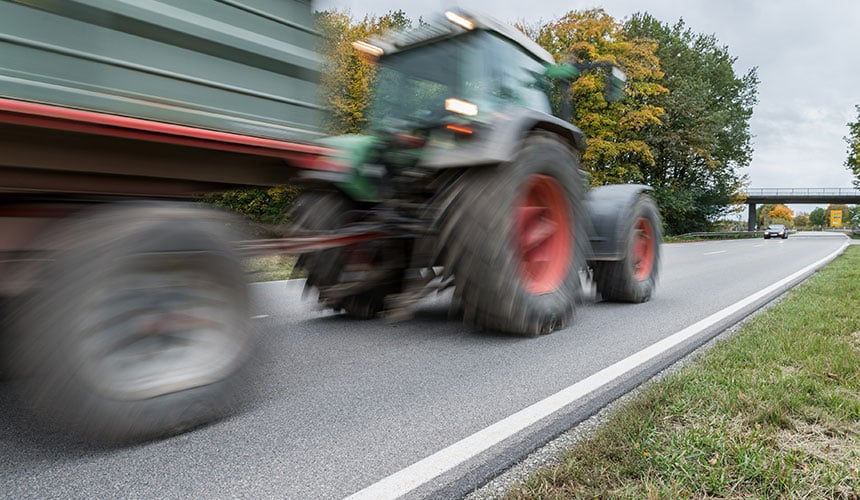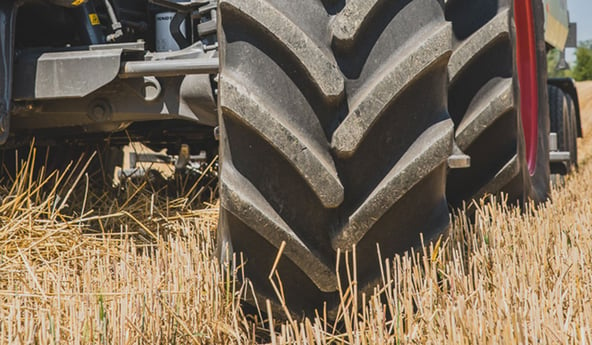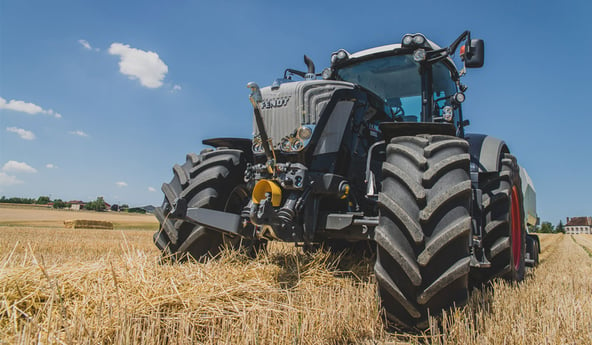Of all your tractor’s safety devices, the overall braking system is the most important one. And contrary to popular belief, it is not made up only of discs, pads or vacuum servo. Also your tractor tyres are essential to obtain the best possible adhesion and transmit maximum braking power to the ground.
There is no point deciding to install a new braking system if your tractor tyres are too worn, not at the right inflation pressure or if there is minor damage to the tyres which will weaken their structure.
Most accidents involving agricultural vehicles take place on the road. A European objective has been set aiming to halve the number of accidents by 2035. European regulations have authorised speeds of more than 40 km/h for tractors, and in order to ensure safety, they have also imposed improved braking capacity for all agricultural vehicles (tractors, trucks, trailers, mounted implements…).
When your tractor or agricultural machinery is brand new, the question does not arise, because normally they should be standard-equipped with hydraulic or pneumatic dual-line braking systems and have quality tyres.
However, not everyone has just invested in the latest-generation equipment and your safety is paramount, especially if you don’t have the resources to change your trailers which might be still equipped with single-line circuits or redo your tractor’s entire braking system.
The tyre is an excellent way to boost your braking system and allow you to reduce your braking distance by several meters in the event of an emergency.
1. What are the forces which impact your braking?
Four-wheel driven tractors are equipped with brakes on the rear axle. During braking, the load on the rear axle is reduced and transferred to the front axle, crushing the front tyre with the tractor mass.
With latest generation tractors, when you brake, the four-wheel drive is engaged. This maintains the front axle in the axis of forward direction while giving the front tyres maximum adhesion, on condition of course that the front tyres are of good quality and in good condition. These are the main forces which impact braking.
How does the braking force work?
Just like tractive force, the braking force works thanks to the tyre’s contact with the ground. It opposes the forward movement of the tractor and causes it to slow down to an extent that depends directly on the coefficient of adhesion of the tyre to the ground.
The intensity of the braking force depends on the deceleration and the tractor’s mass. The force necessary to stop a trailer is proportional to the total mass of the towed equipment. The rate of deceleration therefore determines the distance necessary to stop or slow down the towed equipment. The mass, speed, adhesion of the tyres and strength of the braking system are therefore all essential elements for successful emergency braking.
Distribution of braking and dynamic distribution among axles
During braking, the force is not distributed evenly to each tyre. The rear axle of the tractor could lift and contributes partially towards transmission of the braking force. In this case, the load transfer of the vehicle as a whole, commonly known as the dynamic load, is added to the mass of the front axle, crushing it further. This distribution of forces may destabilise the entire combination vehicle.
If the tractor is combined with a trailer, it depends a lot if the trailer has or not a braking system:
- If the trailer doesn’t have a braking system, when you are braking on the tractor almost all the weight is pulled on the tractor for inertia and you feel clearly how the back is pushing you especially at max speed and max trailer load on a sudden brake.
- If the trailer has a braking system, this effect is really mitigated and has less impact on safety.
Tractors are generally equipped with load sensing proportioning devices to stabilise them during emergency braking. This proportioning device ensures balance between lateral brake forces while preventing the trailer from swaying off course.
Braking distance
The braking distance is simply the distance covered by the tractor and its trailer during deceleration. It may just be a question of slowing down or coming to a complete stop, depending on the driver’s intention.
Tests have shown that speed, more than mass, has a significant impact on braking. For example, for a 40-tonne agricultural combination vehicle driving at a speed of 40 km/h, the braking distance required to bring the vehicle to a complete stop on a dry, flat road will be lies between 22 and 25 meters. An extra 20% distance is needed to come to a stop on a wet road.

Speed has a major influence on the braking distance and the time necessary to bring the vehicle to a complete stop. If you drive at 50 km/h on a dry road with a 40-tonne load, you will need an extra braking distance compared to driving at a speed of 40 km/h in order to bring your vehicle to a complete stop.
2. What are the different braking solutions?
The older tractor models in use are almost all equipped with hydraulic single-line braking systems. The most recent tractors are now equipped with dual-line braking systems, which is to say that the system has two circuits: the first is used by the usual service brake and the second is used for the emergency brake.
For safety reasons, European regulations require the installation of a hydraulic or pneumatic dual-line braking system on all towed or trailed vehicles (trailers, flatbed trailers, spreaders…). For tractors and all their implements, this obligation comes into effect on January 1, 2025.
Hydraulic single-line braking systems
The hydraulic single-line braking system comprises a single brake cable directly connected to the tractor which makes braking possible for towed implements. Regulations prohibit this system from being installed on new trailers as of 2021 and on new tractors as of 2025.
The new European approval authorising agricultural vehicles to drive at over 40 km/h has changed the situation. The law effectively requires a reinforcement of the braking function with the installation of a hydraulic or pneumatic dual-line braking system and the obligatory installation of ABS for speeds of over 60 km/h. At this speed, the hydraulic single-line circuit is not enough to ensure the safety of the driver and other road users in the event of a problem.
Hydraulic dual-line braking systems
In accordance with the applicable European regulations, new agricultural machinery will have to have a dual-line braking system to improve the safety of combination vehicles starting from January 2025.
The hydraulic dual-line circuit is a system which makes it possible to separate the normal braking system from the emergency braking system and is designed to stop the combination vehicle in the event of the failure of the principal braking system. Changing from single-line to dual-line braking represents a relatively low cost because the tractor is already equipped with a hydraulic pump.
Pneumatic dual-line braking systems
Operating in the same way as the hydraulic dual-line braking system, the pneumatic dual-line braking system uses compressed air which provides better braking efficiency. Used for a long time for heavy goods vehicles on the road, it has proved its worth extensively and is perfectly suitable for powerful tractors towing heavy machinery at speeds of 40 Km/h and over.

According to European regulation 167/2013, the installation of dual-line braking, whether hydraulic or pneumatic, is obligatory for all new agricultural tractors and for trailers or interchangeable towed equipment. However, it is necessary to bear in mind that pneumatic and hydraulic are not compatible and this lack of compatibility does not allow you in any circumstances to drive without connecting the towed implements to the braking circuit. Adapting the equipment is obligatory in order to make your implements compatible with the tractor.
3. How can tyre improve your braking capacity?
The tyre is the only point of contact between the ground and the agricultural vehicle. In the event of an emergency stop, the braking force is exerted directly at the level of the tyre and the front axle bears the full weight of the tractor, squashing the front tyres.
When buying tyres, pay attention to the robustness and reliability of the carcass. This is a more important investment, but it will make a difference in situations of great stress.
Several factors could influence the behaviour of the tyre in emergency braking situations:
-
- the tyre contact area,
- the rolling stability,
- the casing stress resistance to load.
Let's take the example of the VX-TRACTOR, which combines these different factors.
The design of the tread and its lugs influence the contact area size of the tyre with the road. With up to 20% more rubber volume, the VX-TRACTOR's lugs provide a large and uniform contact area with the ground. This advantage could be useful to increase the vehicle resistance during braking.
Bridgestone’s robust casing has been engineered to offer outstanding durability and high resistance to damage, even at higher inflation pressures. The casing resistance was optimised to minimise, thanks to its premium layers tread belt, internal stress, resulting in greater durability. The exclusive S-Line bead is also designed for optimum durability by improving the connexion between tyre and rim.
Find out more
The Bridgestone-agriculture.eu blog is written and administered by tractor tyre experts who are available to provide you with the advice you need to help you to maximise your productivity: Technical data for agricultural tyres — Agricultural tyre performance — Air pressure advice — Solutions to avoid soil compaction — Sprayer tyre pressure — etc.
To take it one step further and learn more about the risks linked to the use of unsuitable agricultural tyres or the dangers of inappropriate tyre pressure, download the free white paper below:
Most people who read this article have also read some of the following articles:
This information is intended only to make you aware of the technical and functional aspects of agricultural tires and their use. It does not allow you to make a judgment or a definitive conclusion on a given problem. Only your agricultural tire expert is able to make a technical assessment and take a final decision, case by case.
Leave a
commentary
Your email address will not be published.
Required fields are indicated with *








